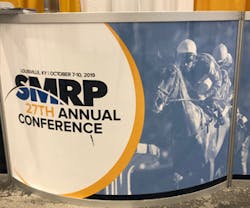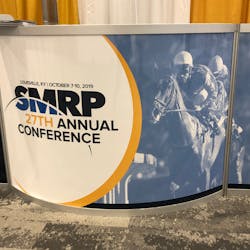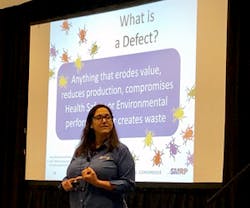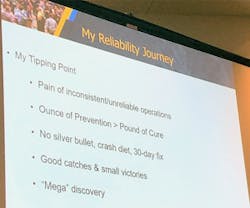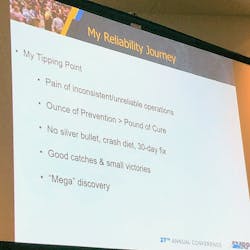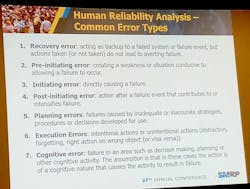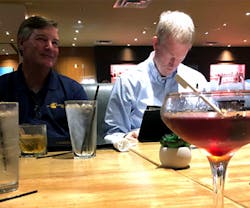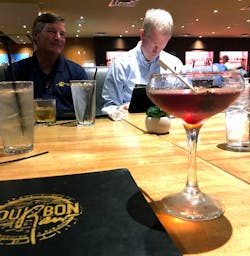Photos from the SMRP 27th annual conference, Louisville, KY
What's your 30-second pitch for reliability? When your plant's reliability engineers (and/or other reliability champions on your team) go to explain to other departments or to upper management why they want to do what they want to do, what message are they taking?
For David Mierau, CMRP, director of reliability engineering at Venice, FL-based PGT Custom Windows and Doors, having a clear, concise, bottom-line-based reliability message to deliver to key decision-makers in the company is part of a reliability engineer's job responsibilities.
“It’s not just ‘This piece of equipment is down all the time,' " Mierau said at SMRP's 27th annual conference on Tuesday. "It’s, ‘Here’s the impact it’s having on our labor business; here’s the business we’re missing; here’s the reason this shift has to work Sunday night when they shouldn’t have to.'"
Having dollar signs--backed by data, not best guesses--attached to the areas of opportunity you see in your plant as well as to the results you're tracking of current reliability investments is critical in gaining buy-in from upper management for reliability investments, Mierau and other presenters emphasized in Louisville this week.
"You should know what one hour of downtime costs at your plant," said David Rosenthal, CMRP, PE, owner of Reliability Strategy and Implementation Consultancy. Furthermore, "You need to know what a good day looks like," he said.
And for middle management and plant-floor workers, demonstrating the impact that new or updated processes have on their value and contribution to the company is essential, presenters said. For Rosenthal, who led a reliability turnaround as a contract maintenance manager at a meat-processing facility, addressing the facility's top 10 equipment "pain points" resulted in the production team being able to meet its weekly schedules, reducing the need for weekend scheduling.
At PGT, the asset management work spearheaded by two "homegrown" reliability engineers and one reliability technician has been so impactful that unplanned downtime is down 50% across all operations; the share of corrective maintenance has fallen from 95% to 50%-60%; production volume has increased; and from 2017 to 2018, $250,000 was removed from the maintenance budget because maintenance costs had fallen.
"(We saw) more than $600,000 in annual cost savings and revenue gain being realized," Mierau said. "At the end of the day, (reliability engineers) are really in that role to generate savings for the company."
Following are photos from this year's event, taking place at the Kentucky International Convention Center in Louisville, KY. Plant Services editor-in-chief Thomas Wilk and managing editor Christine LaFave Grace were on hand to cover this leading annual gathering of maintenance and reliability professionals.
Unbridled spirit...for reliability: The Society for Maintenance & Reliability Professionals' 27th annual conference took place Oct. 7-10 at the Kentucky International Convention Center in downtown Louisville, KY.
"Just like we want everyone to feel like safety is part of their job, we want everyone to feel like defect elimination is part of their job," said Michelle Ledet Henley, president of TMG Frontline Solutions, at her presentation, "Defect Elimination - Not Just More Planned Maintenance" on Tuesday. Giving teams the freedom to choose particular defects they want to work to eliminate--the equipment, design and process pain points that result in inefficient use of resources--will help create ownership, which is crucial for long-term sustainment of the defect elimination effort, Ledet Henley noted.
Downtown Louisville at sunset from the KICC. Attendees of the SMRP's 27th annual conference had the opportunity to attend an offsite networking dinner Tuesday at the Kentucky Derby Museum.
What creates a tipping point for reliability? Several leaders from aluminum rolled products manufacturer Aleris Corp. shared their perspectives during a panel discussion Wednesday. One key takeaway: There's no silver bullet--whether in terms of technologies used or processes and analyses employed, there is no single quick fix that alone can support long-term success. However, a mass of small victories can, in aggregate, create a foundation for sustainable progress. For Blake Hunter, CMRP, an Aleris plant manager in Lincolnshire, IL, "the importance of building a reliability vision, the importance of speaking with data, the importance of talent management"--including continually training workers so they build their skills over time--has been one of his top lessors in moving to the role of a plant manager focused on improving reliability.
"We really need to get human reliability integrated with our equipment reliability," said Jacobs' J.D. Solomon, CMRP, PE, CRE, in a presentation on human reliability analysis on Tuesday. In looking to identify the causes of process breakdowns and reliability failures, what does *not* constitute a human error? Among other things, actions or inaction resulting from unreasonable conditions or expectations. "If it's not reasonable, it's not human error," Solomon said. Unsuccessful actions performed to "save the day" or correctly performed procedures carried out in the wake of an externally initiated failure also don't constitute an error on the part of the person attempting to recover from the failure.
It's Human Capital in the Bourbon Capital: Human Capital columnist Tom Moriarty (left) who presented Wednesday afternoon on the Productive Leadership System, joins Plant Services' Michael Connaughton at Bourbon RAW in downtown Louisville, KY, on Monday.
